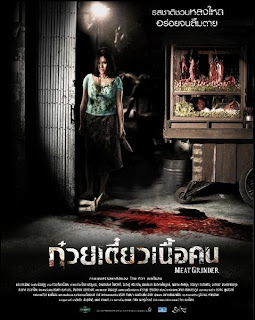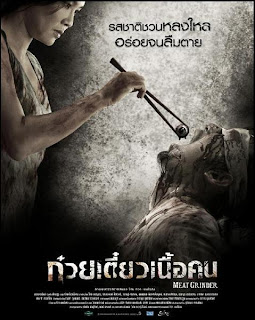
Eden Lake is an UK horror film written and directed by James Watkins and starring Kelly Reilly and Michael Fassbender. According to review aggregator Rotten Tomatoes, the critical consensus holds that the film is "a brutal and effective British hoodie-horror that, despite the clichés, stays on the right side of scary". The site rates the movie as "fresh", with a score of 79% based on 19 reviews.
Here is one review by Steven West from Horror Review:
Writer-director James Watkins - who co-wrote the equally despondent MY LITTLE EYE and has the unenviable task of scripting the upcoming THE DESCENT 2 - has made a nihilistic, relentlessly intense hoodie-generation variation on WHO COULD KILL A CHILD? It takes a well-worn survivalist-horror approach to socially relevant, incendiary material, complete with a blood/shit-caked heroine triumphantly fending off an increasingly brutal enemy and a score by THE DESCENT’s David Julyan that, for a while at least, reinforces her spirited triumph-against-the-odds. It also, however, destroys any sense of conventional hope and subverts the traditional path of the survivalist horror movie, with an uber-downbeat ending that’s as much of a kick in the teeth of the audience as Serrador’s ironic conclusion of CHILD.
While EDEN LAKE is a vastly superior suspense-horror picture in its own right - and among the year’s finest genre outings - it also works as an escalating middle class nightmare scenario exploiting modern Britain’s tabloid-enhanced paranoia about yob culture. Violence begets violence in the authentically bleak world of EDEN LAKE and the generation gap has never seemed so huge. We’re willing our heroes to survive against the all-too-real threat facing them, but Watkins never lets us enjoy their triumph and offers no easy answers or resolutions.
Kelly Reilly and Michael Fassbender are a nice, white, middle class London couple (the film’s depiction of the class divide, notably via an early, questionable scene of them passing by a pub, bothered some) enjoying a romantic weekend break. Fassbender wants to propose to school teacher Reilly at the picturesque lakeside spot of the title. Both are undeterred by ominous graffiti at the entrance that reads “Fuck off yuppie cunts”.
Enjoying a pleasant bit of beach sunbathing, the couple are disturbed by a group of pallid local youths led by an outstanding Jack O’Connell (and their Rottweiler). The gang play their abrasive music loud, leer at Reilly’s bikini-clad body, let their dog shit near where the couple are laying and generally act obnoxiously. Fassbender uses all his will power to avoid acting out of turn, but finds himself unable to stop himself confronting them. This expression of distaste leads to an unending series of increasingly fraught confrontations between the couple and the gang, beginning with trivial vandalism (slashed tyres) and soon escalating to deadly serious. Triggering a grim turn of events in the second half, one of the most upsetting scenes of this movie year involves Fassbender tied up with barbed wire while the gang take it in turns to stab him with switchblades and Stanley knives. (This sequence would have got the movie either banned or heavily censored in the not too distant past in the UK).
Watkins’ harshly violent, deliberately provocative film creates a powerful sense of discomfort by lingering on genuinely cringe-inducing injuries and torture : FX artist Paul Hyett adds to his growing list of impressive credits (THE DESCENT, WAZ, DOOMSDAY) by contributing a horrific spike-through-the-foot, close-up open slash wounds and a truly jolting arterial-spraying throat stabbing involving THIS IS ENGLAND child star Thomas Turgoose that proves a catalytic event in the final stages. The film also realizes the power of suggested violence : one distressing beating is conveyed largely via sound and a single, disquieting reaction shot. Even more powerfully, the final fate of a key character is conveyed via a shot of a closed bathroom door and the sound of horrendous screams. The audience gets to fill in the horrible blanks.
Watkins cleverly manipulates the audience, like Serrador before him, by firing us up and making us yearn to see this callous group of thugs get their comeuppance. When the time comes, however, he refuses to give us the easy option of satiating our bloodlust : the quietly devastating final scene suggests the gang’s ringleader will get away with what he has done. Just as notable is the LAST HOUSE ON THE LEFT-inspired twist of fate that makes the concluding act a truly upsetting diversion from expectation.
To some extent, the script relies on coincidence and contrivance, but you’ll be too gripped and scared to even notice much of the time. The callous youths at the core of the story, who progress from animal torture to single mindedly pursuing the innocent people who could land them in jail, are a terrifyingly credible threat and almost everything that happens feels convincing in our fucked up society. Reilly and Fassbender make for likeable, sympathetic victims.
It’s well shot (repeated aerial shots add to the sense of isolation and desolation), unrelenting and uncomfortably graphic : the briefly glimpsed, off-hand burning of a young Pakistani boy provides at least one indelible image. The harrowing denouement, meanwhile involves the movie’s most overt collision of chase-horror movie and social realist drama…and the effect is utterly horrifying.
(Continue the Trip)












































